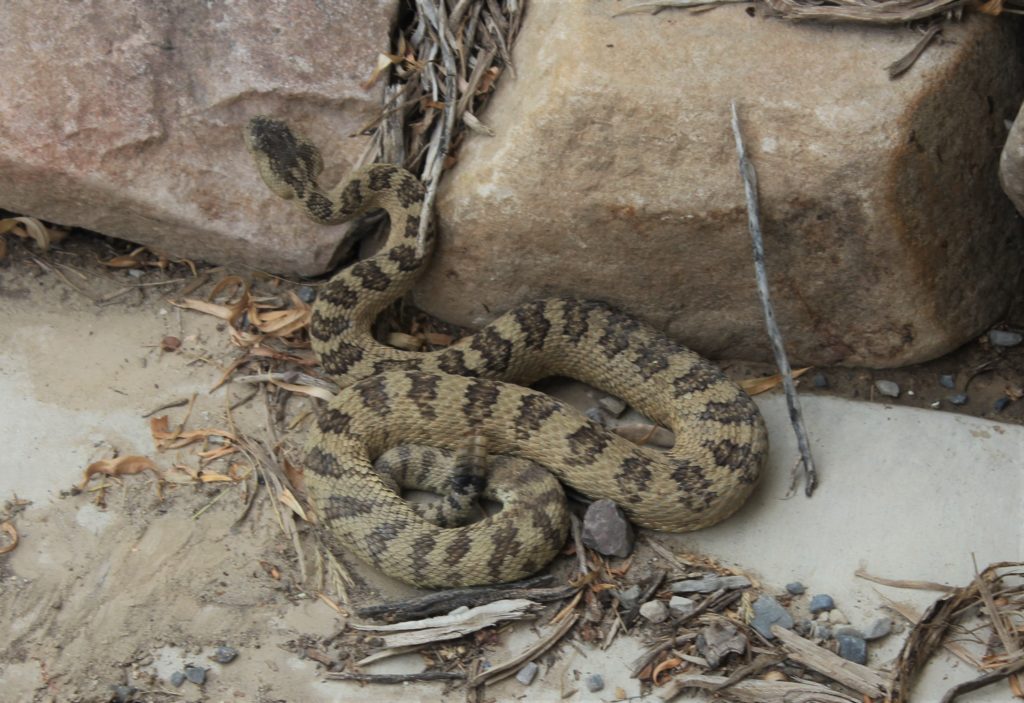We try to live with nature as much as possible. We will tolerate a pest until it becomes a danger to humans, pets, live stock, or our gardens. And when it does become a problem, we try to relocate and discourage it, before we dispatch it. We had such a visitor the other day, one that I would usually watch slither away, but because of the location of this visitor and because it was not letting itself be known, I felt it was a safety issue, and had to dispatch it.

I am by no means a snake expert, but I believe that this guy is a Great Basin Rattlesnake or Crotalus oreganus lutosus. Aimee and I stumbled on this guy when we were getting ready to get into the van. Aimee noticed the pit viper head immediately and I verified it by looking at the tail. I later identified it as the Great Basin Rattlesnake by it’s coloring and other pictures on the internet.
The color pattern usually consists of a buff, pale gray, pale brown, olive brown or yellowish brown ground color, overlaid with a series of 32-49 dorsal blotches. These blotches are dark brown to black in color, with pale centers and pale borders, and are often irregular in shape and wider than they are long. There is also a series of lateral blotches that are indistinct anteriorly, but become more distinct posteriorly and eventually merge with the dorsal blotches to form crossbands. Older specimens sometimes have a faded pattern, or they may have uniformly black blotches, with the dorsum of the head also being black [Source]
As noted above, I would usually relocate snakes, but this one was within 10 feet of our front door, and was not using its rattle. So I instantly felt like I needed to dispatch it, instead of herding it to another location.
It surprised me that this guy was not rattling. He was coiled, just sitting there looking at us. He was sitting behind our chipper/shredder, which I moved to take this picture and to figure out a way to get him to uncoil so that I could take care of the threat. After doing a little more research, I came across an article (“Rattlesnake danger grows as more serpents strike without warning” July 22, 2001) that explains that rattlesnakes are now not using their rattles and are more likely to attack without warning. The Great Basin Rattlesnake is also more timid.
The quickest, and best way that I have found to dispatch a rattlesnake is to put a shovel blade just behind its head and decapitate the snake. But you NEVER want to approach a coiled pit viper. They have the ability to spring and attack the distance of their body when they are in a coiled position. So you want to get the snake to move on, so you can dispatch it while it is not coiled. And this guy was not going to uncoil for me. And he only rattled once, and that was for a second after I poked him with a sprinkler pipe to get him to uncoil and move off.
So, I figured that vibration/noise would make him move. So I fired up the chipper/shredder. He only looked at it, did not move an inch. So I then turned the shredder so that it was now blowing at him. This did the trick, the uncoiled and started to move away from the shredder. I then walked up behind him and with a shovel decapitated the snake.
The problem with snakes, is that they still can move, rattle, and bite after they have been dispatched. This one was no different. After I removed his head with the shovel, I went to pick the head up, with the shovel. His body-less head then bit the shovel. Never, try to pick up a snakes head, even if it is removed from the body. They always have the ability to inject venom through their fangs. I then dug a hole, and promptly buried the head. I then removed the rattle, and then put the body of the snake away from the house to let nature take care of it.
The Utah Department of Wildlife Resources in an article titled “Rattlesnake safety tips – DWR” lists several things to do when you encounter a rattlesnake and how to protect your property from them. Rattlesnakes are actually illegal to kill in Utah (R657-53). The law does have an exception for “reasons of human safety.” -28(6)(a) “Great Basin rattlesnakes, Crotalus oreganus lutosus, may be killed without a certificate of registration only for reasons of human safety.” I agree that they should usually be left alone, and would usually leave them alone, especially if it was in the wild, but because it was a safety risk for me and my family I dispatched the snake.
